In a previous article I explained in detail what ISO does in the camera and what, in general, is the best ISO value to use for astrophotography.
Basically it comes down to finding the ISO value from which the upstream read noise will swamp the downstream read noise. Any ISO value beyond this one has no additional benefit and only decreases Dynamic Range. Remember; ISO does not increase the sensitivity of the camera, increasing it doesn’t capture more light while decreasing dynamic range will hurt our images for instance in star color.
We can look at Sensorgen data to determine this point, although this is not easy to see from the charts in all cases.
So I decided to create graphs which are able to show this ISO value really clear. You can check the graph and look for the point in the curve where the linear trend starts. This indicates the point at which the upstream noise swamps the downstream noise and all we do is amplify the signal and the noise, hurting our dynamic range. These are the noise values where we call a sensor ‘ISO-less’ and there is no benefit in increasing the noise in this ISOless range.
It is good to note and realise that, in general, Canon cameras require a higher ISO value to reach this ISOless range than Nikon cameras for instance. So if you ever find yourself in a debate about which ISO you need to use, it is always good to know which brand and model you are discussing.
You can find the list for Nikon and Sony cameras here;
Nikon cameras.
Sony cameras.
Suggested ISO values
I want to emphasise that the listed ISO values is the suggested value based on the available Sensorgen data. You should always check this data for your specific model and test it to see if it is right.
For some models it might be less clear what the right value is than for others. Furthermore it is possible that there are differences per camera of the same model. You should take this value as a starting point for your own test.
Canon cameras can suffer from banding noise and you might find that you need a higher ISO even than listed below to cancel this out properly.
Furthermore it is important to note that there is good reason to use a lower ISO value for even more Dynamic Range. This could be the case for instance when you expose long enough and the read noise is swamped by the background shot noise and you get the histogram to 1/3 from the right.
Unity Gain
You shouldn’t worry about unity gain. For all suggested ISOs listed below, the read noise is (well) above 1 LSB so the ADC will be dithered properly. You can find more info here on unity gain and why you shouldn’t worry about it.
Please let me know in the comments below if you think a suggested ISO value is incorrect or if you are missing a camera model in the list!
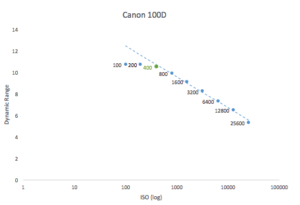
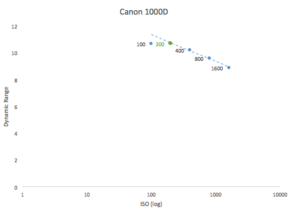
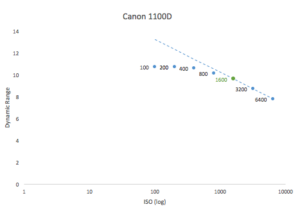
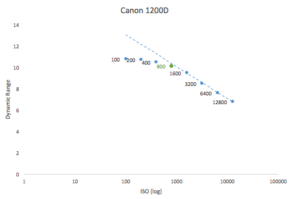

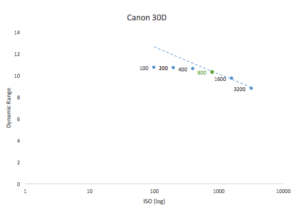
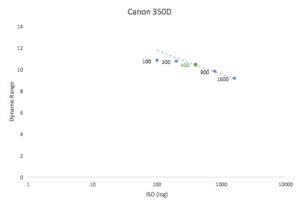
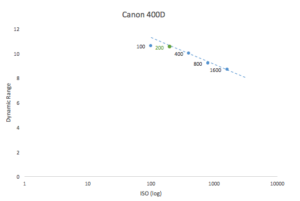
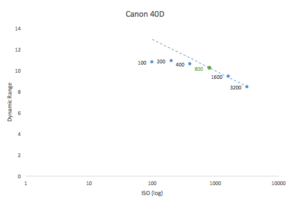
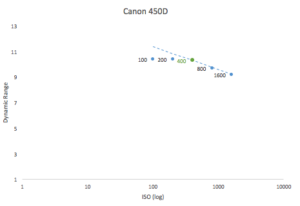
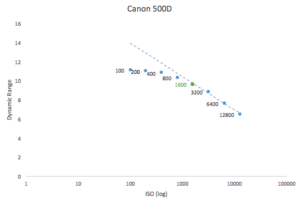
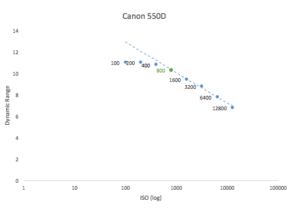
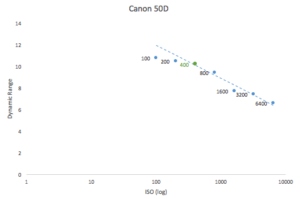
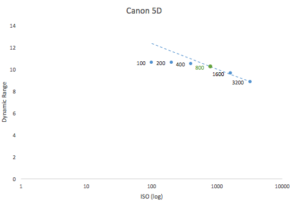
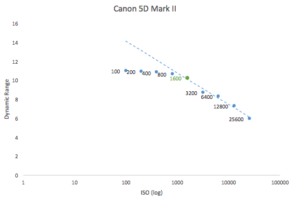
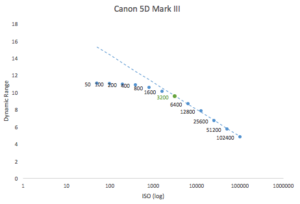
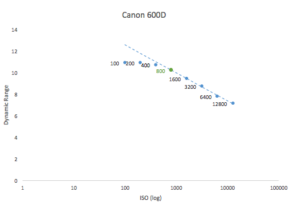
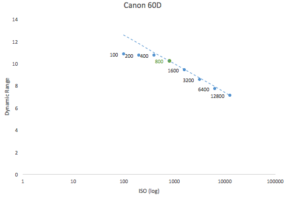
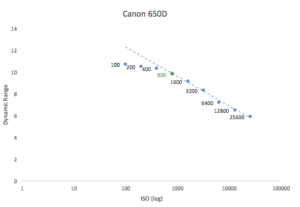
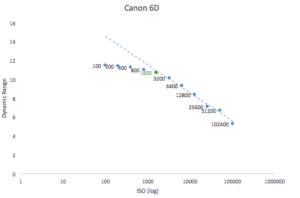
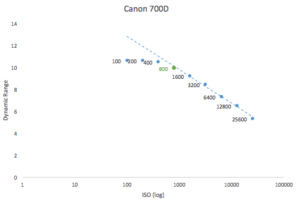
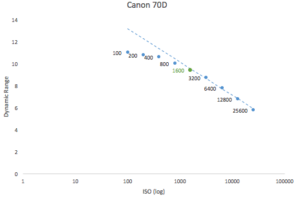
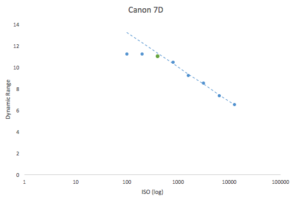
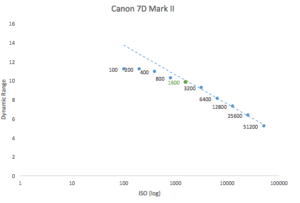

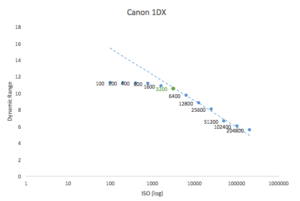
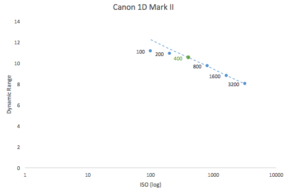

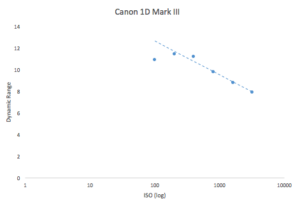
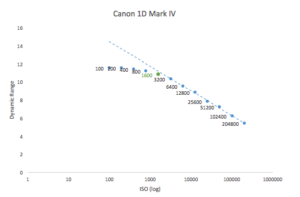

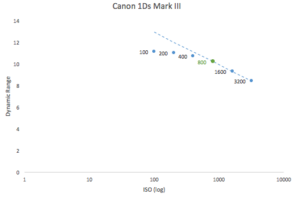

How interesting how the Canon 80D has more dynamic range than the flagship models….if I am reading the graph correctly.
That’s indeed interesting. It is due to fact that it is more or less ISOless. It seems similar to how most Nikons behave (finally I would say 😉 )
more dynamic range, ye… but only 100 – 200 best iso???
Hi! this is an argument that always puzzles me.
I read countless articles suggesting 1600ISO for my canon D700 but I still I have one doubt: I read somewhere that if you don’t expose for enough time, fainter parts of the DSO may not “send” enough signal to your sensor. This is an argument for keeping lower ISO to have longer exposure time. Is it right?
In my high polluted sky, I can shot 4 minutes exposures at 400 ISO (IDAS LPS filter, newton f4) to reach mid histogram, at 1600ISO I can shot for 1 minute only. Is 1 minute enough for the above consideration?
I bet there should be a balance between the total exposure time and the time for a single shot.
Suppose you can shoot so many frames to raise SNR considerably (how many? 100-200?), then: should you lower your ISO to let photons for fainter parts reach the sensor?
I also made some tests, but I’m not sure about the procedure:
1. comparing single frames (JPG files) at 400, 800, 1600 ISO (with 4, 2 and 1 minute exposure): images seem identical, even photoshop statistics have same figures: being the high ISO frames more I could conclude that SNR in stacked image should be better at high ISO but …
2. comparing stacked sets of three ISO gave me no significative difference
Now I’m really confused, maybe the big amount of light pollution make the considerations about the ISO irrelevant to me?
Actually those are some excellent points.
Please note that I attempted to make clear that the listed ISO values are the highest values that would make sense to use. There are good reasons to use lower ISO values and you mention one of them. Theoretically: if you are not read noise or dark current limited it should not matter if you take 10x1min or 1x10min exposures. This might very well be the case in your high light polluted situation. I guess that could explain the results you are getting.
[…] of Canon DSLR's. He also has links for Nikon and Sony. I thought y'all might find this useful. Best ISO values for Canon cameras | DSLR Astrophotography […]
Hello, can you include Canon 77D or Canon 200D?
Thx for this web,
Luis
I’ve also got the 77D and am looking for it to be added.
Great information. Wondering what the best ISO for the new Canon 5D MIV? Can’t seem to find this anywhere
Looking at the DR graph on DxOMark I think it’s a subtle curve at the start, but it seems to be there. So I would try ISO200, 400 as well as 800 just to be sure.
The real linear part of the graph seems to start at 800, so most likely there is no reason to go beyond that.
Pity this is outdated as my 77D is a newer model and not reflected here. Anybody perhaps know where I can access similar info regarding the 77D?
For cameras not listed here, I suggest looking at the dynamic range graphs on http://www.photonstophotos.net or http://www.dxomark.com (they should agree). Choose the lowest ISO setting at which the curve is still a straight line rather than bending down. You’ll find there was a major change in DSLRs starting around the Canon 80D — the best speed is 200 on the newer models, 800 or 1600 on the older ones.
Thankyou for doing this!
I have an 800d… will you be updating this list at all? since it has same chip as 80d would it be the same ISO settings?
Planning to do an update soon!
The 80D values would be a good starting point! However, the electronics around/behind the sensor could be different which could mean different ‘optimal’ ISO values.
The Canon 100D (first in the list) has a recommended ISO of 800, but the graph shows the sweet spot in green at 400. From Sensorgen the DR at ISO 400 is 10.5 stops, and 800 is 9.9. So is the 800 recommendation a typo?
Thanks for all you do here!
that’s a typo indeed! Thanks for spotting it and letting me know!
I think you are missing a main and importend fact: SNR and the weather.
And you overweight the DR. DR can nearly be forgotten, just dont care about it.
You recommend something like ISO400 for some cameras, e.g. the canon 7D.
But: When using it at ISO400 you will loose lots of signal compaired to ISO1600.
The loss of DR when using 1600 is somthing not to care about, it has no effect, due to the fact, that in most cases astro-subframes are never perfectly exposured and mostly unerexposured.
There is nearly no benefit in using ISO400, but lots of Singal or SNR benefits when using ISO1600
Ok, one could do a 4 times longer integration-time, thats right. But: Short summer nights and bad weather…
Ok, one could go for 4 times longer sub-exposures, thats right. But: What about sigma-cliping with less sub-frames, what about dithering with less sub-frames, what about not perfect guiding and longer sub-expo-times?
So over all:
Under dark skys there is quite no benefit form using ISO400 but lots when using ISO1600 (a better SNR).
And this stands for allmost all canon.models since ~2012 or so.
I would never could capture faint ISM/IFM nebulae when using ISO400, but I do with ISO1600.
I just dont have the time to capture 80 hours of integration-time. But I do have 10 or 15 hours.
ISO1600-SNR is much much more worth, than better DR or so-called “less noise” with ISO400.
Please read the linked article about how ISO works as it addresses the points you raise.
Simply put; ISO is simply amplifying signal. You don’t gather more light if you increase ISO. There is NO signal gain in using higher ISO’s. So it comes down to the types of noise and their amplification. After quite specific values there is no SNR gain anymore as all the camera is doing is simply amplifying both the noise and the signal. And then there are two main arguments for not opting for the higher ISO: DR and control over the amplification (I’d rather do it myself than let the camera do it).
You make the direct connection with exposure time and this is simply not relevant to do when talking ISO. moving up from ISO 400 to 800 doesn’t give you twice the signal. It’s still the same amount of signal you captured, so you can’t use half the exposure. This reasoning has been tought to us in daylight photography, but is not accurate and falls apart while doing astrophotography
“moving up from ISO 400 to 800 doesn’t give you twice the signal. It’s still the same amount of signal you captured, so you can’t use half the exposure. ”
In fact it works.
Using a canon 7D with ISO1600 you DO get a equal image.
I can 4x lower the integration-time for same result as using lower ISOs with longer integration time.
Of course I dont “earn” more photons from the sky, but I’m amlifying signal.
And no: Noise is not boostet 4times.
There is your point:
You claim boosting the ISO over a certain point will boost all types of noise the same amount, so there would be no benefit.
But this is wrong.
Not all types of noise are boostet the same way signal is boosted.
Just try it out.
Higher ISO has no disadvantage, but lots of benefit.
Lower ISOs like 200, 400 and (for most cameras) 800 will just lead to longer interation time needed, without any benefit in noise.
And DR:
It just dont matters.
DR is only in place when: a) perfect exposure time, b)High DR within the picture.
Decrease in DR on higher ISOs is quite low.
It drops less than one stop from ISO800 to ISO1600 and again less than one stop from ISO1600 to ISO3200.
With ISO1600 there is still a DR of ~10 stops.
You will never use the DR-capabilities of your sensor, when not ETTR. And in fact in Astrofotografie nearly noone gets to ETTR, its always underexposured.
Beside all of this:
ISO-invariant cameras like the sonya7s have fantastic in-camera denoising tools, that cant be switched of. You never get a raw-image.
So an image taken with ISO100 and lifted in post will be more noisy than an image taken with higher ISO.
In-camera amlification does a better job, than we can do.
You stated, “..Using a canon 7D with ISO1600 you DO get a equal image.
I can 4x lower the integration-time for same result as using lower ISOs with longer integration time …”
NO, you do not !
A 4 minute image at 400 ISO = 15:1 SNR <<< Better!
A 1 minute image at 1600 ISO = 7.5:1 SNR <<< Worse!
A 1 minute image at 1600 ISO will have TWICE the NOISE as a 4 minute image at 400 ISO.
I can clearly see that the 1 minute image at 1600 ISO is worse.
WHY can't you?
Increasing the ISO (Gain) does not, and cannot, make up for the lack of PHOTONS.
When stacking astro-photos …
a) Increasing the exposure time reduces the relative Shot Noise in the final image
b) Fewer, but longer, exposures minimizes the Read Noise
Astro-Photos require a huge Dynamic Range.
The very faint nebulosity is buried deep within the shadows,
while simultaneously the very bright stars and emission are clipping white.
If the faint nebulosity is clipped to pure-black then
that information is lost forever.
If the bright stars and bright red/blue emmission is clipped to pure white then
that information is lost forever.
In fact, most cameras do NOT have enough Dynamic Range to properly process M42 – the Orion Nebula!
Astro-photograpghy requires a carefull selection of …
a) ISO and Dynamic Range
b) Lens ( Focal Length and F-Ratio )
c) Individual image exposure time
e) Total number of exposures
d) Total exposure time
to minimize Noise and maximize SNR to acceptable levels.
You cannot simply keep increasing the ISO, while reducing the exposure time, and expect better images.
I recently purchased the Canon 90D which came with a EFS 18-135mm lens. I also have the MSM star tracker system and would appreciate any recommendations on camera settings and if this lens is suitable for astrophotography. I am new to this field and any insight would be greatly appreciated. Thanks in advance , Troy ~ email: hivoltage_tv@yahoo.com
Hey, I have an Canon SL2. Have you tested one of these yet?
Could you please add the Canon SL2 (200D)
Thanks.
Many thanks for this information as a starting point for Astrophotography. I have a Canon 800D and have referenced the 80D ISOs as suggested and use Daylight balance. I use the Canon 800D with a Canon fixed 200mm f2.8 lens for planet or DSOs. However, at 100 or 200 am unable to capture anything beyond the moon and brighter planets. No DSO shows up unless, I put ISO at 1600 say for 60-90 secs. At 120secs, I can get away with using 800. For Milky Way shots, with a Rokinon 18mm f2.8, anything less than 1600 for less than a minutes gives no detail. Is there something else that should be done or are the ISOs indicated above incorrect for an 800D (you mention the sensor/electronics may be different to an 80D)? I look forward to your thoughts. Many thanks.
Thanks for your question.
First of all; are you shooting in RAW? if not, start doing so 😉 Then white balance doesn’t matter and you should be able to stretch your image when processing your images. As explained in the articles on this blog, higher ISO should not matter other than what you’d be seeing on the back of your camera screen. Don’t worry if nothing is showing up, that’s completely normal and most often you will only see your results after stretching.
Secondly; are you ‘stacking’ multiple exposures? If not you might wanna look into that.
Lastly; use very high ISO’s to target and frame your object you are photographing (so that you see it as a preview on your screen) and then use the appropriate ISO and process it on your computer later. (and be pleasantly surprised 😉 )
As I’ve shown in another article you should be able to catch things as Andromeda and Orion nebula already with 3sec exposures (!!)
Many thanks for your reply and confirmation on ISO. Using my laptop, I set up an imaging plan, track, capture RAW images at various ISO and exposures, do stacking and rendering (curves, gradients etc). Thanks for the link – once Andromeda gets high enough in the sky (July on) for us in NZ, will try for that as night falls earlier. Orion comes out well at ISO1600 or more. Just bought a Canon 6D so will look forward to see difference on next imaging. Best wishes.
How can the 70D be better at 1600 and the 80D just 200? Am I reading the info in the wrong way?
The detailed way of implementation of the signal chain and the hardware used (like the AD converters) will determine the behaviour of the camera and how it handles ISO values. It could very well be different hardware that is causing this.
Hi there, thanks for this explanation.
If I understand you correctly, you are saying that above a certain ISO value (which is camera specific), the ISO used will not provide any more detail to the image and may in fact reduce the amount of information due to overexposure.
However, since I am using an Alt/Az mount, I need to be mindful of my exposure time to avoid field rotation, so using a high ISO will help me here. Assuming I’m targeting a dim DSO (so even if the background stars are overexposed it doesn’t matter), should I be using the maximum ISO of my camera so that the exposure time is minimised? Or will the noise floor be increased more at higher ISO levels?
Let’s also assume I wont be purchasing a polar eq mount soon 🙂
Thanks.
Hi,
Thanks for your question.
I’m not sure if you read this article; https://dslr-astrophotography.com/iso-dslr-astrophotography/ but there I try to explain that you should NOT think of ISO and Exposure time as connected. They are both control different things and the main thing to understand is that ISO does NOT influence the amount of light you capture.
So for your situation it is still best to use the recommended ISO setting even though exposure time needs to be short because of tracking.
Higher ISO would simply mean higher amplification of both the signal and noise and you’d be better of processing the image on your PC and amplify the signal there.
Hi there, thanks for your reply, old lessons I learnt from the photographic film age die hard 🙂 What makes it harder is that you certainly get brighter images on the screen with a higher ISO, and we don’t tend to look at the increase in noise level until later. Those high ISO numbers certainly look very tempting in the cold and dark. Thanks again for the explanation, Andrew.
[…] Astrophotography. (2019). Best ISO values for Canon cameras. [online] Available at: http://dslr-astrophotography.com/iso-values-canon-cameras/ [Accessed 4 Apr. […]
Great articles, very helpful and has changed my view and understanding of ISO. An update would be very nice—I have an 800D as well.
[…] DSLR Astrophotography. (2019). Best ISO values for Canon cameras. [online] Available at: http://dslr-astrophotography.com/iso-values-canon-cameras/ […]
Thank you for your contribution.
Do you have any ISO data for the Canon 60DA
Thank you
Hi there! Awesome article you have there, but is there any way you could give the numbers on the 1300D/T6?
Which one would you guys recommend for a beginner.
This does not make much sense. The higher the ISO the better, as you get more sensitivity, meaning, you need less exposure time to capture the same amount of light. Sure, you need to find you sweetspot in terms of noise, but you still want to get ISO as high possible. Cheers!
You might want to read this post on ISO and why it is a common misunderstanding that it increases sensitivity.
http://dslr-astrophotography.com/iso-dslr-astrophotography/
Thanks a lot for your article helped me a lot, still no updates for the 800D? I checked on dxOmark and still no sensor review for that model :/. Is it confirmed that the performance are equals or closes to the 80D?
Hi,
I’m using Canon 6D Mark II and would like to know what the minimum average and the highest ISO would be good to use to get a clear picture. Please let me know at your earliest convenience. I look forward to your reply.
Hi chrisvdberge, I found your page informative, thank you. Are you going to update the Camera prosperities of newer Astro DSLRs i.e. Canon Ra Etc?
Cheers Varna
You have done a wonderful job explaining the complexities of iso and dynamic range. Could you point me in the right direction for finding the “suggested iso” for the Canon 200D, Rebel SL2? Thank you!
Your page was always a great help for my astrophotography progress. Now i wonder if you plan to add the mirrorless cameras (R, RP, etc) to this chart?
Thanks for your kind words. I’m planning to do a big update soon!
Would yo please add for SL3/250D? You could get iformatin here https://www.photonstophotos.net/Charts/RN_e.htm
I presume the dynamic range is in bits – the scales are not labeled.
If so it is useful to remember that 1 bit = 0.756 magnitudes. Therefore 8 bits is 6.049 mag, 10 bits is 7.562 mag and 12 bits is 9.074 mag. The others you can work out by simple magnification.
[…] + mehr hier sehen […]
Heyo Chris Thanks a mill for all your effort. Really appreciated and valued.
May I ask why I all over read “NO “in-between” iso values. I have a 1D IV, DX, 6d
The 1’s are too heavy for the tracker.
I found the 1d4 blows all others out of the water when it comes to wide-angle astro normally use 1600 with a 14mm 2.8 lens
The 6d I used till now with 1250 most of the time. Had one try with 1000 and a few with 1600.
What is ur suggestion please.
Go low but maybe “in-between” or stay high at 1600?
Thanks again for your time to ask maybe stupid sounding questions
Hi Guido,
Thanks for your question. The reason why it is recommended to not use the in between stops is that these are not ‘real’ ISO values. The camera will use the closest ‘full stop’ and scale the image accordingly to mimic the in between stop.
Please note however that we’re talking extreme cases here when we talk about (deep sky) astrophotography. I can very well imagine that this won’t make a practical difference in your wide-angle astrophotography.
Hello, hope you are doing well !
thanks for the job.
do you have any data for the Canon R5?
Many thanks for clearing up my misunderstanding of the high ISO/noise myth from my 1970s film days.
Now I am trying to balance several factors (noise, white clipping, dynamic range).
My camera is ISO-invariant (by your awesome graphs) at 1600. An informative YouTube (Robin Glover) suggests in my Bortle 7 backyard at f/8, 300 mm, I shoot 120” subs. I have always used 30” to keep from clipping bright stars. I am anxious to try longer exposures as I have never been happy with star color I achieve. I hope my guider is up to the challenge.
But, how can I use lower ISO (400-800) to achieve better DR and/or avoid blowing out bright stars with long exposures unless I sacrifice by introducing low ISO-based noise?
Am I missing something?
Is one (DR v. clipping v. noise) more important than the others for decent shots?
Thanks again!